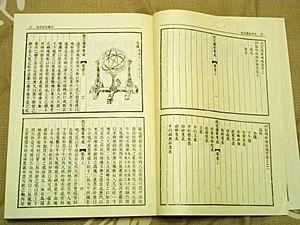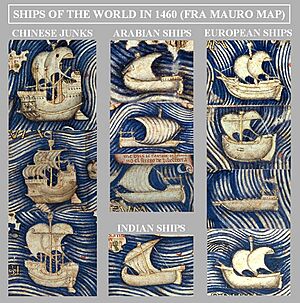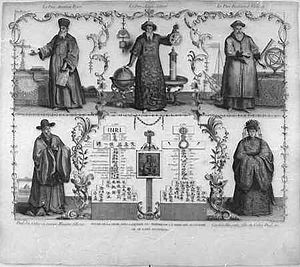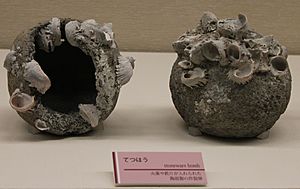History of science and technology in China facts for kids
Ancient Chinese scientists and engineers made amazing discoveries and inventions! They were leaders in many fields like science, engineering, medicine, and astronomy.
Some of their earliest inventions include the abacus (a counting tool), the sundial (a clock using shadows), and the Kongming lantern (a type of hot air balloon). The "Four Great Inventions" are super important: the compass, gunpowder, papermaking, and printing. Europe didn't know about these until about 1000 years later! The Tang dynasty (from AD 618 to 906) was a time of huge progress.
Later, in the 16th and 17th centuries, European scientists called Jesuits came to China. They shared Western science and astronomy, and also took Chinese knowledge back to Europe. In the 19th and 20th centuries, Western technology helped China modernize. A famous historian named Joseph Needham and his partner Lu Gwei-djen studied a lot about China's science history.
Contents
Early Chinese Discoveries

About 2500 years ago, during the Warring States period, the crossbow was invented. This weapon was so powerful that armor became less useful! During this time, many different schools of thought existed in China. These "Hundred Schools of Thought" advised rulers.
Mo Di and Logic
Mo Di (also called Mozi, who lived around 470-391 BCE) taught important ideas like how to build strong defenses. He also introduced the idea of fa (principle or method). A group called the School of Names used this idea to explore logic. However, this study of logic stopped when Mo Di's supporters lost power.
Ancient Chinese thinkers also made lasting contributions to Traditional Chinese medicine, including acupuncture and herbal medicine. Acupuncture might have been used as far back as 1000 BC!
Early Records and Architecture
The Chinese used shadow clocks and the abacus to record observations. They documented what might be the first solar eclipse in 2137 BC. They also made the first record of planets grouping together around 500 BC. The Book of Silk, from about 400 BC, was the first detailed map of comets. It showed 29 comets and what events they were linked to.
In architecture, the amazing Great Wall of China was built by the first Chinese Emperor Qin Shi Huang between 220 and 200 BC. The Qin dynasty also developed the crossbow, which later became common in Europe. Crossbow parts have been found with the Terracotta Army soldiers in Qin Shi Huang's tomb.
Han Dynasty Innovations

The Eastern Han dynasty (25–220 AD) was a time of great inventions.
Zhang Heng's Inventions
The scholar and astronomer Zhang Heng (78–139 AD) invented the first water-powered spinning armillary sphere. This device helped him map 2,500 stars and over 100 constellations! In 132 AD, he created the first seismological detector, called the "Houfeng Didong Yi." This urn-shaped instrument could drop a ball to show when and where an earthquake happened. In 2005, Chinese scientists successfully made a copy of it.
Ma Jun's Mechanical Wonders
The mechanical engineer Ma Jun (around 200–265 AD) was another brilliant inventor. He improved the silk loom and designed mechanical chain pumps to water gardens. He also built a huge, complex mechanical puppet theatre powered by a hidden waterwheel.
Ma Jun's most impressive invention was the south-pointing chariot. This complex machine acted like a mechanical compass vehicle. Experts believe it used a differential gear, similar to what's found in modern automobiles, to help wheels turn at different speeds.
Early Flight and Tools
Sliding calipers were invented in China almost 2,000 years ago. The Chinese were also the first to successfully experiment with aviation. The kite and the Kongming lantern (an early Hot air balloon) were among the first flying machines.
The Four Great Inventions
The "Four Great Inventions" are the compass, gunpowder, papermaking, and printing.
Paper and Printing
Paper and printing were developed first. Printing was recorded in China during the Tang dynasty, though the oldest printed cloth patterns are even older (before 220 AD). The earliest known printed document is the Diamond Sutra from 868 AD.
Gunpowder's Discovery
Pinpointing the compass's exact invention date is tricky. The magnetic pull of a needle was mentioned between 20 and 100 AD, but clear records of magnetized needles appear in 1086.
Around 300 AD, an alchemist named Ge Hong wrote about what happens when saltpetre, pine resin, and charcoal are heated together. This was an early step towards gunpowder. An old Chinese book from about 850 AD describes how mixing sulfur, realgar, saltpeter, and honey can cause "smoke and flames," even burning down houses!
Global Impact
These four inventions changed China and the world! For example, gunpowder reached Arab countries in the 13th century and then Europe. The English philosopher Francis Bacon wrote that printing, gunpowder, and the compass "changed the whole face and state of things throughout the world." They changed literature, warfare, and navigation.
A very important military book, the Huo Long Jing, was written by Jiao Yu in the 14th century. It described how to use fire arrows, rockets, fire lances, firearms, land mines, naval mines, and cannons. It even mentioned different types of gunpowder, like 'magic gunpowder' and 'poisonous gunpowder'.
Movable type printing, invented by Bi Sheng (990–1051) in the 11th century, was later improved by Wang Zhen (wooden type) and Hua Sui (bronze metal type).
China's Scientific Progress

Early China had many engineering achievements, including matches, dry docks (for repairing ships), the double-action piston pump, cast iron, the iron plough, the horse collar, the multi-tube seed drill, the wheelbarrow, the suspension bridge, the parachute, natural gas as fuel, the raised-relief map, the propeller, the sluice gate, and the pound lock. The Tang dynasty (618–907 AD) and Song dynasty (960–1279 AD) were especially innovative times.
In the 7th century, book-printing developed in China, Korea, and Japan. They used hand-carved wooden blocks for each page. Movable type was also used in China but was later set aside because of the huge number of Chinese characters. It wasn't until Johannes Gutenberg in Europe that movable type became widely used.
The Chinese also improved weapons like Greek fire, using devices called Meng Huo You and Pen Huo Qi around 900 AD. These devices used a pump and nozzle to spray fire.
Song Dynasty Achievements
The Song dynasty (960–1279) brought stability and encouraged learning and new ideas. Trade grew, and technology was supported. In 1080, mints produced 5 billion coins! The first banknotes were made in 1023.
Famous Inventors and Scientists
Many famous inventors lived during the Song dynasty. The statesman Shen Kuo wrote the Dream Pool Essays (1088 AD). In it, he described using a drydock to repair boats, the magnetic compass for navigation, and the idea of true north (how the compass needle points slightly away from true north). Shen Kuo also developed a theory for how land forms, called geomorphology. He even thought that climates could change over long periods.
Another talented statesman, Su Song, was known for his amazing Astronomical Clock Tower in Kaifeng (1088 AD). This tower was powered by a waterwheel and a special escapement mechanism. At the top, a large bronze armillary sphere rotated mechanically. Su Song also created an Illustrated Pharmacopoeia (1070 AD), which described botany, zoology, mineralogy, and metallurgy.
Astronomy and Archaeology
Chinese astronomers were the first to record a supernova (a huge star explosion) in 185 AD. They also observed two more famous supernovas during the Song dynasty: SN 1006 (the brightest ever recorded) and SN 1054, which created the Crab Nebula.
During the Song dynasty, the study of archaeology grew. People became interested in ancient objects. Shen Kuo used an interdisciplinary approach, combining archaeology with studies of metals, optics, astronomy, and geometry.
Geology and Climate
Shen Kuo also made important ideas about geology and climatology in his Dream Pool Essays. He believed land changed over time due to erosion and new layers of silt. He saw fossils in a cliffside and realized the area was once an ancient seashore, which had moved hundreds of miles over a very long time. He also noted that petrified bamboos found in dry northern areas meant that climates naturally shifted over time.
Chemistry and Medicine
Early Chinese medicine used simple dried herbs or unprocessed minerals. These were sometimes combined into "elixirs of immortality." These early experiments led to the first observations of chemistry in ancient China. Alchemists tried to make minerals like cinnabar and gold dissolve in water so they could be consumed.
In the Middle Ages, there were big advances in traditional Chinese medicine. In 657 AD, a huge book was put together that listed 833 medicinal substances from stones, plants, animals, and more. Su Song's Illustrated Pharmacopoeia also categorized herbs and minerals by their uses and described animal species and where they lived.
Clocks and Magnetism
Su Song's book Xinyi Xiangfayao described his amazing astronomical clock tower. It used an escapement mechanism and the world's first known chain drive to power a rotating armillary sphere. It also had 133 clock figurines that sounded the hours by banging drums and gongs!
The first person to use an escapement mechanism for a water-powered celestial globe was Yi Xing in 725 AD. Later, Zhang Sixun used liquid mercury in his clocks because water would freeze in winter.
Shen Kuo's writings also include the first description of the magnetic needle compass. He also described experiments with the camera obscura (a device that projects an image), and the invention of movable type printing by Bi Sheng. Shen Kuo also described a method for making cast iron similar to the modern Bessemer process. He discovered the idea of true north and magnetic declination (how the compass points slightly away from true north), which helped navigators.
To make up for deforestation caused by using charcoal in iron production, the Song Chinese learned to make coke from bituminous coal as a substitute.
Mathematics
Qin Jiushao (around 1202–1261) was the first to use the zero symbol in Chinese mathematics. Before him, blank spaces were used. Pascal's triangle was first shown in China by Yang Hui, though it was described earlier by Jia Xian.
Alchemy and Taoism
Taoists were often linked to alchemy because they searched for an elixir of life and tried to create gold. While these experiments didn't work as planned, they led to discoveries of new metal alloys, porcelain types, and dyes.
Experiments with different materials led to many useful ointments, creams, and mixtures. An Arab book from the 9th century listed Chinese inventions like waterproof cream for clothes and weapons, a special Chinese lacquer for leather, a fire-proof cement for glass, and waterproof cream for divers' silk clothes.
Gunpowder Warfare
The use of gunpowder weapons changed warfare forever. A 10th-century silk banner shows the first picture of a fire lance, an early type of gun. The Wujing Zongyao military book (1044) had the first written recipes for gunpowder, used in bombs thrown from catapults. By the 13th century, iron-cased bombs, hand cannons, land mines, and rockets were developed. By the 14th century, the Chinese had heavy cannons, exploding cannonballs, two-stage rockets, naval mines, and a special wheellock mechanism to light fuses.
Jesuits and Western Science

In the 16th and 17th centuries, Jesuits brought Western science and astronomy to China. They were admired for their knowledge of astronomy, math, and geography. They translated Western science books into Chinese and sparked interest among Chinese scholars. They also made detailed astronomical observations and the first modern maps of China.
The Jesuits also shared Chinese knowledge with Europe. They translated Confucius's works into European languages. These writings greatly influenced European thinkers during the Age of Enlightenment, especially those interested in combining Confucius's moral ideas with Christianity.
Why China's Science Slowed Down
Historians often wonder why China didn't have a "scientific revolution" like Europe, and why its technology fell behind. Many ideas have been suggested. Some say the Chinese political system wasn't good for scientific progress. Others, like Joseph Needham, thought that Chinese cultural beliefs prevented science from developing further. They believed nature wasn't ruled by strict laws that humans could easily figure out.
Some historians argue that China did have a scientific revolution in the 17th century, but it was different from Europe's.
More recent ideas focus on economic reasons. One idea is the "high level equilibrium trap." It suggests that China had such a large population and cheap labor that they didn't need machines. Thousands of workers could do any task quickly. Other events, like trade restrictions, wars, and political instability, also kept China from having an Industrial Revolution. Some historians also point out that Europe gained many resources from the New World, which helped its development.
Jared Diamond suggests that China's geography (a wide plain with big rivers and a smooth coastline) led to a single government without much competition. If a ruler didn't like new inventions, progress could stop for a long time. In contrast, Europe's mountains and islands created many smaller, competing countries. If one ruler ignored a new invention, a neighbor might use it to gain power.
Modern China's Science and Technology
The Republic of China (1912–1949)
During the Republic of China (1912–1949) period, modern science truly arrived in China. Many Chinese students went to study in Japan, Europe, and the US. They returned to teach and start new schools and universities. This led to huge growth in modern science. When the Communist Party took over mainland China in 1949, some scientists and institutions moved to Taiwan.
People's Republic of China
After 1949, China organized its science system like the Soviet Union's. Even though government policies like the Great Leap Forward and the Cultural Revolution caused scientific setbacks, China still made big progress in nuclear weapons and launching satellites.
From 1975, science and technology became one of the "Four Modernizations," meaning it was vital for national economic growth. This led to advances in agriculture, medicine, and genetics. In 2003, the Chinese space program made China the third country to send humans into space. China aims to send a person to Mars by 2030.
In the 2000s and 2010s, China became a top scientific and industrial power in advanced fields like super computing, artificial intelligence, bullet trains, and nuclear physics. In 2016, China published more scientific studies than any other country, including the US.
Images for kids
See also
 In Spanish: Historia de la ciencia y la tecnología en China para niños
In Spanish: Historia de la ciencia y la tecnología en China para niños
- Chinese astronomy
- Chinese mathematics
- History of Chinese archaeology
- List of Chinese discoveries
- List of Chinese inventions
- List of inventions and discoveries of Neolithic China
- Military history of China
- History of canals in China
- Science and Civilization in China
- Traditional Chinese medicine
- Two Bombs, One Satellite
- Yongle Encyclopedia



